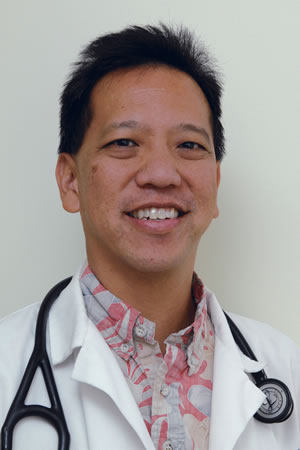Living With Cystic Fibrosis
Dr. Roger Yim
Pulmonary critical care and sleep specialist at The Queen’s Medical Center
Where did you receive your schooling/training?
I went to high school at Saint Louis, college at UC-Berkeley. I came back to Hawaii for medical school, and did my internship and residency at UH. I did my fellowship in pulmonary critical care and sleep at Northwestern in Chicago.
How long have you been practicing?
Ten years.
What is cystic fibrosis?
Cystic fibrosis is a genetic defect where a person has problems with their sodium chloride channels. A lot of the cystic fibrosis patients in the Islands are military – Caucasians tend to be carriers of the gene. It’s an autosomal recessive disease, which means you need to get a gene from your mother and your father to get the disease. If you have the gene from only one parent, you’re just a carrier. Once you have the defect, problems with the sodium chlo-ride channels affect a lot of organs, including the pancreas and the lungs. The pancreas doesn’t produce insulin properly and mucus in the lungs becomes really thick, and the person becomes prone to getting infections.
How does a person know they have cystic fibrosis?
Most of them will present when they’re infants with repeated infections and they get tested when they go in for a checkup.
How prevalent is it?
In the grand scheme of things, it’s a rare disease. Many more are carriers than actually have it.
Is the disease life-threatening?
Yes. What they end up dying of is usually lung infections because through repeated infections, the lungs get damaged. They end up having cysts or holes in their lungs. They also get scarring, what we call pulmonary fibrosis. Once the lungs become damaged initially, the more prone they are to getting repeated infections because the lung isn’t normal after that. It’s usually pneumonia that ends up taking them, or their lung function becomes so poor that they need to have a lung transplant or they will die.
What is the average life expectancy?
In the 1980s you wouldn’t live past your teenage years, past 14, but now they live into adulthood. In the U.S., the median age is about 37. In Canada, it’s a little longer, it’s about 47. I’m not sure why that is. The disease just isn’t as severe? Is it the air, the diet? They use the same treatments we do.
Usually the pediatrician or pediatric pulmonologist will see them only up to age 18, but in my training, we had an adult cystic fibrosis clinic. Some of the pediatric pulmonoligsts see patients past 18 because they’ve been working with them so long and they understand the disease. But if they’re going to live until 40, they want to pass them on to an adult clinic.
Why has life expectancy increased so dramatically?
Life expectancy has increased because we understand the disease better and we’ve improved on the treatments. A lot of it is treating the symptoms to try to keep the lungs clear of the thick mucus, so we use saline, which helps to clear out the mucus. The hypertonic saline is nebulized – they breath it in. Then we have a therapy vest, which works using percussion and compressed air – the vest shakes to help them shake up the secretions and clear it. And we treat any infections as soon as possible using antibiotics. A lot of cystic fibrosis patients are colonized from young with bacteria, that means it’s in the lungs. It’s not causing a problem, but as they start to have thicker mucus and their lungs start to get damaged, that bacteria starts to cause problems. Usually when they’re infants they have staphylococcus aureus, and as they start to get a little older toward the teenage years it starts to change over to pseudomonas. With pseudomonas, you need multiple antibiotics because the bacteria start to form resistance. A lot of the treatments that we have involve newer antibiotics, and we also do some inhaled antibiotics to try to use the IV only as needed. We may do one month with the inhaled antibiotics, one month off. That’s not to get rid of the infection, it’s to suppress the bacteria.
Do healthy people have these bacteria, but we tend to be able to keep them at bay?
Most of this bacteria is only in damaged lungs, and pseudomonas is one of those that can be seen in the hospital, what we call hospital-acquired pneumonia, and it’s very tough to treat.
Is there a way to treat the genetic defect rather than just the symptoms?
Research is looking at gene therapy, but that’s still way down the road. They do genetic typing and there’s one gene with one single defect that’s really common in 70 percent of people with cystic fibrosis, but there’s more than 1,000 genetic defects that can lead to cystic fibrosis.
They’re trying to look at the genes to see how they respond to certain treatments. There’s a lot of ongoing research.







